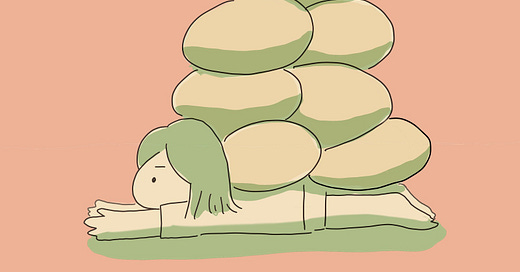Dear Health Policy Enthusiasts,
We are back with a new newsletter that talks about an issue that is important but not talked about often : Compassion fatigue. Those working at the frontlines are put face to face with harrowing situations often. However, it can take toll on workers themselves. How do we ensure that those who are taking care are taken care of themselves?
Today’s newsletter is written by guest author Akshay Narayanan, Manager - Impact Programs at Guardians of Dreams, a non-profit that works to transform the quality of care across Children’s Homes in India.
Hope you enjoy this article.
Until Next Time,
AD and Linda
Please follow Global Health Connect on LinkedIn, Twitter and Instagram. Subscribe to our newsletter below. If you are interested in submitting content to us or sharing a job posting, email us at submissions@globalhealthconnect.pro.
Roughly 35 million children in India are classified as children in need of care and protection. Those with the greatest capacity to intervene are community workers in the child protection system, responding to the needs of children at the most precarious intersections of poverty, abuse, and violence. Their ability to show up in full force every single day is the foundation for building a safety net for our most vulnerable children.
On the ground, what does children’s vulnerability look like? According to the Juvenile Justice Act in India, these children are at risk of violence and exploitation within and outside families. We're talking about survivors of sexual assault, those engaged in child labour, some trafficked across district and state lines, and children in conflict with the law. During COVID-19, the Lancet estimated that more than 1.9 million children lost one or both parents, along with a dramatic increase in reported abuse, food insecurity and learning losses. These indicators have yet to stabilise three years into the pandemic. Civil society organisations, particularly those involved in community-facing work, form a key part of the national strategy to mitigate the impact of the pandemic. Having spent 5+ years working with childcare institutions that care for vulnerable children, I am acutely aware of the value of our community-based efforts. I am just as aware of the emotional investment and risks that this community work necessitates. Handling these stressors on the job is not a personal responsibility. As we build organisations, we must identify and prevent compassion fatigue and the resulting burnout in our community workers.
What is compassion fatigue?
Working with marginalised communities, especially with children in crises, you encounter secondary trauma on a day-to-day basis. While listening to stories of neglect and violence can motivate change and inspire anger with existing systems, it is possible and likely for community workers who are new to the profession to be overwhelmed. A common byproduct of repeatedly encountering distressing information, absorbing vicarious trauma and having to power through it all, is compassion fatigue. Pioneering psychologist Charles Figley described this phenomenon as a cost to caring, the exhaustion brought on by second-hand experiences of stress and pain of the people being helped. This is pronounced when, as community workers, you encounter information that you cannot act upon, realities that you cannot change. Often, when investigating a child's poor performance in school or their behavioural outbursts in childcare institutions, I learn of their histories, of cycles of violence that they’ve witnessed in their own communities. I often feel an immediate and powerful desire to keep the child safe. I want to erase their histories. I want to rage at the system that failed to protect them. To continue doing my work, I must put aside any feelings of helplessness to focus on what can be done- feasible mitigation measures. I am responsible for taking the information about their past and using it to create support systems. But, an honest account of my experience is that the information directly impacts me. For me, this can present in two distinct ways. One- I’m unable to move past this account of trauma- constantly thinking about it even outside of work with rare occurrences of nightmares in my sleep. The alternative experience is one of numbness. As a defence mechanism, my mind and body shut down. I refuse to talk about the subject or even avoid it intentionally if it comes up in conversations. My experiences aren’t unique. Several child welfare practitioners have written about similar coping strategies for compassion fatigue. Research has shown that social workers working with communities that deal with highly traumatic experiences like child sexual and physical abuse are at a higher risk of feeling this chronic stress.
Why should we be worried about compassion fatigue?
Compassion fatigue can often lead to disillusionment in a social worker’s ability to effect change and is closely linked with burnout. Community workers can lose their energy and idealism in what they set out to accomplish. Studies in occupational medicine and organisational psychology have linked experiencing compassion fatigue with frequent absences, higher staff turnover rates, reduced team morale, and compromised decision-making. Training young community workers to provide services in traumatic environments requires teams to create support systems for processing challenging information. This will affect the quality and effectiveness of your interventions and influence the longevity of community workers.
What can we do?
I am fortunate to be a part of a team that has consciously taken steps to cultivate a culture of care for our field team. A culture of care begins with organisational norm-setting around open discussions of emotional challenges. I believe community workers need to have an outlet to talk about feelings that hide in shame. When they are on the verge of burnout, community workers may feel ashamed that they cannot summon the will to overcome their emotional exhaustion. They may feel pressured to maintain a face of normal levels of effectiveness and interest in their work. Guilt often sets in when they realise how desensitised or indifferent they have become to the suffering they see in their communities. My team uses well-facilitated weekly circles to discuss these heavy feelings. We talk about the challenges we face without focusing on problem-solving. The goal is to feel comfortable sharing in a trusted space and have others weigh in on reframing the situation. These circles build trust and closeness among colleagues, helping them support each other emotionally. Feeling supported allows us to be strong and handle the job challenges better. In these circles, it is helpful to have senior community workers with sufficient on-ground experience. This is important because new community workers are sponges for new information. This information can and will influence their attitudes towards the profession and communities they work with. It is helpful to role model how challenges can be discussed without pessimism overtaking the room. In this case, the circle should ideally be limited to people directly doing community-based work with first-hand knowledge of compassion fatigue. Frontline perspectives are often unique and emotionally nuanced, which might differ from the experiences of administrators or managers.
Secondly, a culture of care needs to be accompanied by institutional processes that quickly adapt to the needs of community workers. When you notice that a community worker is withdrawn, unable to discuss difficult details of their work and has expressed distress, it might be important for them to take a break. It is not wise to double down and power through but to shift focus to activities under their control. Suppose the community worker’s fit within the program is found to be affecting their mental well-being, transitioning their role to another function should be made easily accessible and must be the manager's highest priority. One way to ensure these field placements are dynamic is to increase the frequency of 1:1s for young community workers with their managers - an opportunity to problem-solve compassion fatigue, burnout, chronic stress and other emotional difficulties before it’s too late.
When you work with children, it takes almost two decades to see the outcomes of your efforts. This necessitates a long-term investment of not just money and time but of energy and hope. You can feel sadness, frustration and rage at injustice while being hopeful, engaged, and inspired to make change happen. For those who care about changing the world for our children, it is imperative to be mindful of self-care and care for our colleagues to continue fighting the long fight.
Akshay is your friendly neighbourhood development enthusiast from India, often found under a tree in Cubbon Park in Bengaluru. He is keen on building sustainable, data-driven caregiving interventions for our most vulnerable children. He is also likely to deliver unsolicited lectures on queering science, mobilising communities, and engaging in a somatic practice. If you would like to hear more of his rants, reach out to him on twitter, linkedin, or email.





